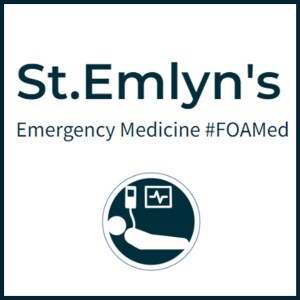
Welcome back to the St Emlyn’s podcast! Today, we're diving deep into the world of diagnostic testing in emergency medicine, inspired by a recent discussion featuring our esteemed colleague Rick Boddie. This episode sheds light on the complexities of diagnosis, the probabilities involved, and the importance of shared decision-making with patients.
Understanding Diagnostic ProbabilitiesOne of the critical points raised by Rick is the significance of understanding diagnostic probabilities. For instance, if a population has a 10% prevalence of a condition and we use a test with 90% sensitivity and 70% specificity, the post-test probability can be less than 2%. This scenario prompts the question: should we discharge a patient based on this probability or admit them for further testing?
In emergency medicine, our goal is to identify patients with serious conditions efficiently. Consider a thousand patients with chest pain; if the prevalence is 10%, around 100 of them will have the disease. With a 98% sensitivity test, we'll identify 98 patients but potentially miss two. However, this translates to missing only one in 500 patients overall, which is relatively low but still significant when considering the potential consequences of a missed diagnosis.
Consequences of Missed DiagnosesThe consequences of a missed diagnosis can vary. For some conditions, missing a diagnosis might not lead to severe outcomes. For instance, a small subarachnoid bleed might never recur, or an early-stage appendicitis could resolve on its own. In such cases, there might be no adverse consequences, and the patient could even benefit by avoiding unnecessary treatments.
However, for conditions like myocardial infarction (MI), the stakes are higher. Missing an MI can lead to severe complications, including cardiac arrest. Yet, it’s crucial to recognize that not every missed MI will result in a catastrophic outcome. Often, patients with missed diagnoses will experience further symptoms, allowing them another opportunity to seek medical attention.
Balancing Diagnostic Accuracy and Over-InvestigationIn emergency medicine, we constantly balance the need for diagnostic accuracy with the risks of over-investigation. Over-investigating can lead to false positives, unnecessary treatments, and additional harm to patients. Therefore, it’s essential to adopt evidence-based guidelines and principles that help us make informed decisions without overburdening the diagnostic process.
One approach to achieving this balance is through shared decision-making with patients. Engaging patients in discussions about the risks, benefits, and potential harms of diagnostic tests can lead to better outcomes and increased patient satisfaction.
Shared Decision-Making in PracticeShared decision-making is particularly valuable in complex cases, such as evaluating pregnant women for pulmonary embolism (PE). In these situations, the standard diagnostic pathway might involve tests that expose the patient and fetus to ionizing radiation. By discussing alternative diagnostic interventions, such as leg ultrasounds or modified VQ scans, we can involve patients in the decision-making process and tailor the diagnostic approach to their specific needs and concerns.
The Legal and Institutional PerspectiveFrom a legal and institutional perspective, adhering to established guidelines and evidence-based practices provides protection for clinicians. If a missed diagnosis occurs despite following these principles, it is considered an acceptable risk within the diagnostic process. This understanding helps mitigate the fear of legal repercussions and allows clinicians to focus on delivering the best possible care based on current evidence.
Communicating with PatientsEffective communication with patients is a cornerstone of good medical practice. Instead of giving definitive statements like "you do not have this condition," it's more helpful to say, "we haven't found anything serious this time, but if you have any further symptoms or concerns, please come back." This approach not only sets realistic expectations but also encourages patients to seek further care if needed without feeling dismissed.
The Role of Technology in DiagnosticsLooking to the future, advancements in diagnostic technology could revolutionize emergency medicine. Imagine having a tool that could predict a patient's 30-day outcome or a "painometer" to measure pain levels accurately. Such innovations would enhance our ability to make precise diagnoses and provide targeted treatments, ultimately improving patient care.
ConclusionDiagnostic testing in emergency medicine is a complex, nuanced process that requires balancing probabilities, understanding the consequences of missed diagnoses, and engaging in shared decision-making with patients. By adhering to evidence-based guidelines and maintaining open communication with patients, we can navigate these challenges effectively and deliver high-quality care.
At St Emlyn’s, we continuously strive to improve our diagnostic approaches and encourage open discussions about these critical topics. We invite you to share your thoughts and experiences with us on our website or via Twitter. Together, we can enhance our understanding and practices in emergency medicine.
Stay tuned for more insights and discussions in our next podcast episode. Until then, keep exploring, learning, and advancing the field of emergency medicine.
More listening about diagnosisPodcast – Diagnosis in Emergency Medicine Part 1 – SpIN and SnOUT
Podcast – Diagnosis in Emergency Medicine Part 2 – Beyond a simple yes or no
Podcast – Diagnosis in Emergency Medicine Part 3 – The importance of prevalence
More Episodes
 2017-03-05
2017-03-05
 3.7k
3.7k
 2017-02-14
2017-02-14
 4.9k
4.9k
 2017-01-06
2017-01-06
 4.0k
4.0k
 2016-12-13
2016-12-13
 5.4k
5.4k
 2016-12-09
2016-12-09
 4.2k
4.2k
 2016-11-17
2016-11-17
 3.4k
3.4k
 2016-10-29
2016-10-29
 11.3k
11.3k
 2016-10-03
2016-10-03
 3.3k
3.3k
 2016-09-15
2016-09-15
 4.1k
4.1k
 2016-09-09
2016-09-09
 6.5k
6.5k
 2016-08-17
2016-08-17
 4.3k
4.3k
 2016-08-10
2016-08-10
 4.8k
4.8k
 2016-06-26
2016-06-26
 4.3k
4.3k
 2016-06-22
2016-06-22
 3.1k
3.1k
 2016-06-16
2016-06-16
 3.9k
3.9k
Create your
podcast in
minutes
- Full-featured podcast site
- Unlimited storage and bandwidth
- Comprehensive podcast stats
- Distribute to Apple Podcasts, Spotify, and more
- Make money with your podcast
It is Free
- Privacy Policy
- Cookie Policy
- Terms of Use
- Consent Preferences
- Copyright © 2015-2024 Podbean.com




